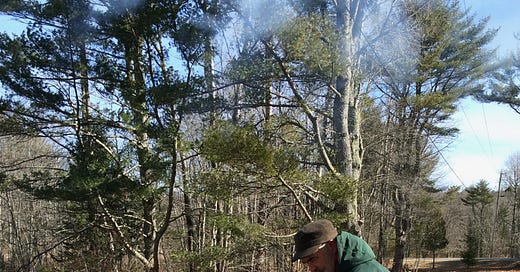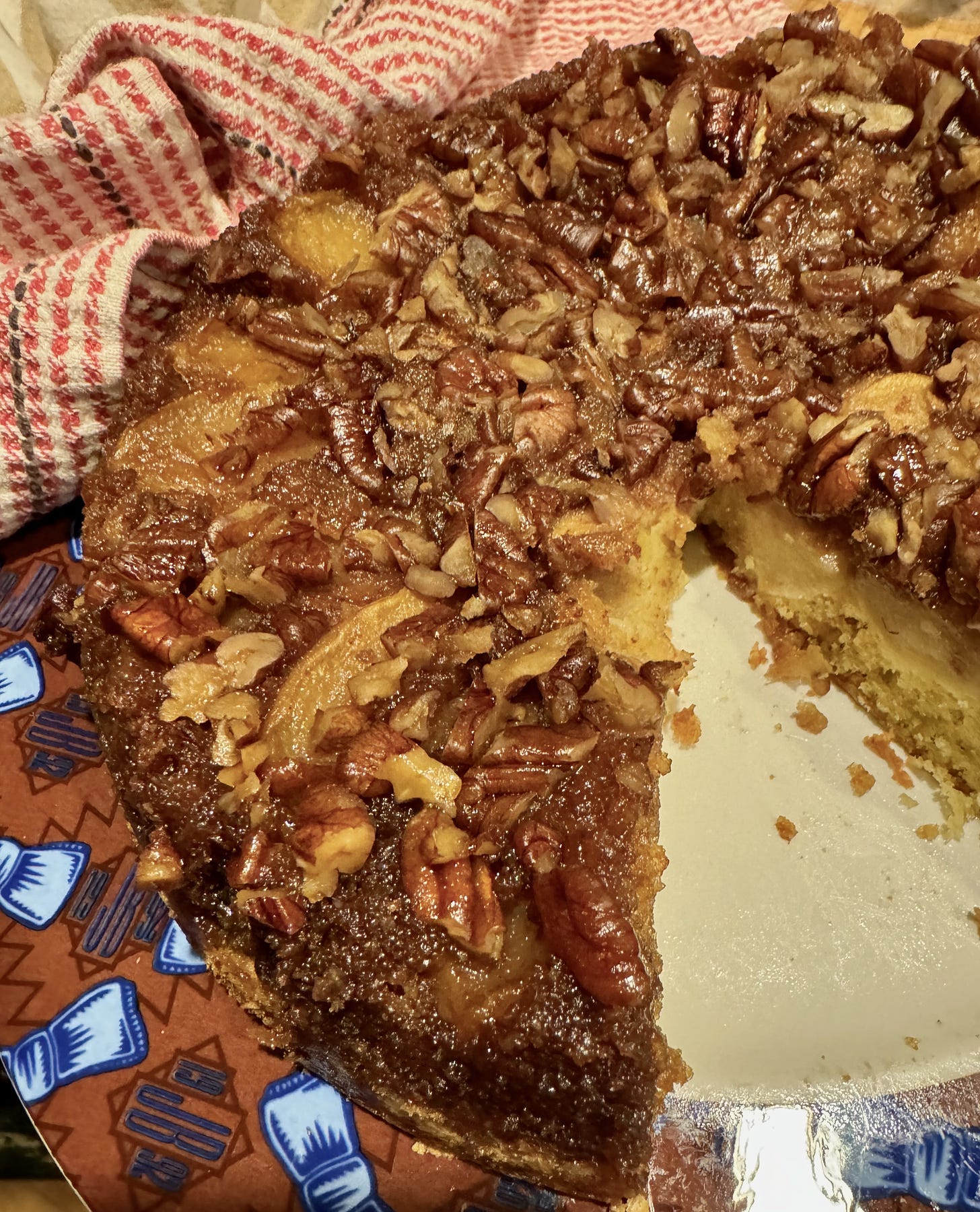Season's gifts: maple syrup & more scallops
with recipes for maple glaze, maple-apple upside-down cake, and scalloped scallops
Maple Syrup Season
In New England maple syrup season gets earlier and earlier with each passing year. Maine Maple Sunday is an annual celebration of the state’s sweet harvest when all the syrup producers offer an open house to see how it’s done and sample the wares. It’s always the third Sunday in March, which this year is March 24, a week before 2024’s early Easter. But many Maine syrup producers already began tapping their trees in late January and February, as the temperature started to warm.
Did you know that maple syrup and maple sugar had a role to play in American politics? In the contentious years leading up to the Civil War, Abolitionists stressed the use of maple sweeteners to avoid sugar produced by enslaved Africans in the Caribbean. Boycotting cane sugar, they sweetened their coffee and tea with maple sugar made on a Yankee farm.
“So long as the maple forests stand,” a Vermont almanac advocated in 1844, “suffer not your cup to be sweetened by the blood of slaves.” Who says food isn’t political????
It’s not just syrup season that starts sooner. Frost heave season, a calendar event that is possibly unique to northern New England, also begins a lot earlier these days. Used to be, they say, that after town meeting sometime in March, the select board would send a fella out to post the roads where thawing-and-freezing had heaved the road bed into treacherous speed bumps. This year several towns had to schedule posting way back at the beginning of February.
It’s climate change, of course. This winter that’s drawing to a close has seen temperatures above average week after week, and even the periods of intense cold were nowhere like what they used to be.
So, winters are milder, spring comes earlier, and wild swings in temperature are not good for (wo)man or beast or maple syrup. It might be up in the 50’s one day and then drop to the 20’s less than twenty-four hours later (I’m talking Fahrenheit—in Celsius that would be highs of 10º and lows of negative 6º). A few decades ago, I remember a period of three weeks in January when the temperature fluctuated over 30 degrees and never got up to freezing. And several more decades ago—oh, really, a century ago perhaps—Penobscot Bay froze so hard that folks walked from Islesboro island across to Lincolnville on the mainland, three miles, on the ice. I know that’s true because I once met a woman who had done just that.
What maple tappers need is this: Sunny days with temperatures above freezing but not by a lot—somewhere in the low to mid-40s is ideal, and then nights that are consistently below freezing. So that freeze-thaw/freeze-thaw alternating daily throughout the weeks of late winter into spring starts the sap rising in the trees. When the temperature stays in the high 40’s over a period of days, the trees naturally start to seal the holes that have been drilled to let the sap flow. Modern vacuum tube systems, that stretch their lines throughout the sugar bush and connect the sap directly to the sugar shack, can cope with temperature problems, but you still need a consistent sap flow.
That sap, which is a colorless, very lightly sweet liquid (just 2% sugar) with an elusive grassy flavor, must be boiled to evaporate the water as soon as possible after it’s collected, otherwise it starts to ferment. (This inevitably reminds me of olive oil which must be extracted immediately after harvesting the olives, otherwise they too will ferment and develop off flavors.) It used to be that the evaporator was a broad shallow pan that was constantly being topped up with fresh sap while a fire burned steadily underneath, fed by logs from the surrounding woods. Nowadays, commercial producers have fancier rigs fired by propane and sometimes controlled by an elaborate computer network. It does take some of the picturesque glamor out of maple syrup but the stuff still tastes just as good, whether it’s produced with wood or gas. If they haven’t already, someone, one of these days, will figure out how to rig a solar method so we can have sun-dried maple syrup.
High-end producers, like my favorite Frontier Maple Sugarworks, way up on the Canadian border in the North Woods, use a system of reverse osmosis that extracts much of the water and concentrates the sweetness before the sap gets to the sugaring off stage. That way, say owners VJ Guarino and Carrie Braman, less energy and much less time produces a syrup that is 67% sugar, the ideal.
Well, enough of the mechanics. Whatever the problems, whatever the method, it’s still an exciting time when the sap begins to rise and billowing clouds of smoke and steam issue from sugar shacks, signaling that the season is under way. That dark, thick amber syrup, as sweet as sugar but with its own indefinably haunting aroma, moves the kitchen back a century or two to some very old-fashioned recipes that make sense in modern kitchens.
Of course it’s best poured over a stack of breakfast pancakes, but it’s also great substituted for honey in almost any recipe. And I like to use maple syrup as the basis for a glaze or marinade for chicken or pork or a thick-cut piece of salmon fillet to roast in the oven. Recently I marinated chicken thighs and drumsticks for a Sunday lunch. Scroll down to see the recipe, along with a delicious maple-apple upside-down cake.
Resurrecting Recipes: Scalloping Scallops
Perfection salad stands for a certain kind of old-fashioned American cuisine, largely the product of WASP kitchens, featured in cookbooks and ladies’ magazines that were faithfully followed by WASP homemakers. It was the epitome of middle-class elegance, disdained by the aristocracy, such as it was, and equally so by new immigrants who were utterly bewildered by a combination of shredded cabbage and carrots, slivered celery and green peppers, sometimes chunks of radishes and pineapple, and occasionally sliced pimiento-stuffed green olives, the whole encased in a sugar-sweetened lemon or, more daringly, lime Jello. It was perfection indeed, especially suitable for a ladies’ luncheon. Perfection Salad is also the title of Laura Shapiro’s masterful take on women and food at the turn of the last century. Take a look if you want to know more—the story is riveting, and all too true.
Often we’re appalled at what our grandmothers and great-grandmothers used to prepare, for family and guests alike, back when over-cooking seemed to be the primary kitchen technique, with vegetables boiled for a minimum of 30 minutes or more. At other times, though (and quite possibly with other mothers and grandmothers too), the food of days gone by is the subject of yearning, nostalgia, of almost forgotten tastes and textures that linger on the edges of memory. Such a recollection haunts me when I think of a double-layer chocolate cake with fudgy frosting and walnuts embedded in it that was sometimes waiting for us when we got home from school in the late afternoon. Or the briney, winey, sinus-penetrating aroma that filled the kitchen in the fall when They (the parents) made Pottsfield pickles from all the garden produce.
So it was that I dialed up my memory for my mother’s recipe for scalloped scallops, inspired by a reader’s query after I wrote about scallops a couple of weeks ago. Did I know of a recipe for scallops with Ritz crackers? the reader asked.
Immediately I was back in that warm kitchen looking down over a snowy orchard to the Megunticook River, iced over at this time of the year. In winter, when scallops were in season and rich flavors were welcome, she made scalloped scallops, baked in a gratin dish with a sauce of cream and butter and grated cheese. While she and my father relished the dish, my sister and I wouldn’t touch the stuff. Like many children, we hated scallops. (I also hated lobster and clams though I loved any kind of finfish, mackerel, hake, and especially baked stuffed haddock, another prize from my mother’s kitchen.)
Remembering how she loved scalloped scallops, I went back to the few cookbooks of my hers that I still have but searched in vain. Nothing. Nowhere. I expect she made scalloped scallops the same way her mother did, in Grandmother Thorndike’s day possibly without the Ritz crackers, possibly with plain saltines or even ship’s biscuit which my Thomaston grandmother, the captain’s wife, would have known well.
But Ritz crackers were what the reader asked for and that’s what my mother used, so Ritz crackers it would be.
I searched in old and new Maine cookbooks, including the great two-volume Maine Community Cookbook, a compendium put together by my friends Karl Schatz and Margaret Hathaway, which you can find here. I searched the New York Times’s archive of recipes. I searched online. And gradually, picking up a little bit here, a little bit there, I began to put together a recipe for this simple, very old-fashioned, and yes, to my adult palate, utterly delicious dish.
I’m not one for short cuts in the kitchen. It’s true, there are cans of beans or broth or tomato sauce in my pantry, but strictly for emergency uses. So that bright red box of Ritz crackers had never darkened my shelves—until now. I donned a disguise, sunglasses and a kerchief hijab wrapped style around my head, and ventured to the supermarket for a giant box—who knew how many I would need? And then I drove down to Port Clyde where my friend Glen Libby has a fish mongery (is that a term?), selling fresh-off-the-boat, whatever-comes-in-that-morning. I knew Port Clyde Fresh Catch had scallops and it also afforded me an opportunity to stock up on Glen’s superb made-by-himself crab cakes and fish cakes, a freezer staple at my house. I don’t think I need to add, but I shall do so anyway, that the scallops Glen sells are “dry,” meaning they have not been treated with sodium tripolyphosphate (STPP), to bleach and plump them.
The scallop excursion also gave me a glorious if abbreviated twenty-mile road trip on a brisk winter morning when the cloudless sky was that intense lapis blue that Maine skies get in the coldest winter weather. Route 131, which runs along the St. George River from Thomaston down to Port Clyde, passing through Tenant’s Harbor and Martinsville before reaching the end of the peninsula, courses through some of the most iconic Maine landscape imaginable, ending with tiny Marshall Point lighthouse. When the surf is high and the wind is up, Marshall Point is as picturesque a place as you can find to gaze on the wonders of creation.
So I had my Ritz crackers and I had my scallops and I scavenged from various sources and put this together.
But first, let me just address a pet peeve: recipes that require a kitchen full of pots and pans and bowls, box graters, slotted spoons, stick blenders, and mixers, all of which, dishearteningly, must be cleaned up afterward. I think it’s one of the aspects of cooking that tends to keep people away from the task. It’s okay, no, it’s fun, to make a devil’s food cake. But then, when the cake is iced and served and consumed, the cook with a bellyful of chocolate contemplates the cake pans, the mixing bowls (at least three, more often four), the mixers, the palate knives, the spoons, the measuring cups, with something like despair.
Just so with a lot of the scallop recipes I found on line, many of which were clearly developed by a star chef with a kitchen staff to scurry around behind the scene, tidying, cleaning, styling the food, and mopping up any stray drop of sauce before the cameras were focused.
My solution, pared down and pulled together, does require two pans and a bowl but one of the pans is the dish in which the scallops are baked so it doesn’t count. Scroll down to see the recipe.
The recipes below, for Maple Glaze, Maple-Apple Upside-Down Cake, and Scalloped Scallops, are for paid subscribers only.
Keep reading with a 7-day free trial
Subscribe to On the Kitchen Porch to keep reading this post and get 7 days of free access to the full post archives.








